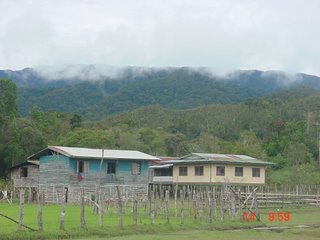I have seen several successful examples of communities benefitting from ICT over the last few years. Yesterday's post on the "E-Bario Knowledge Fair" reminded me of one that I regard as one of the most successful - the e-Bario project.
The district of Bario comprises a small group of remote Kelabit communities in the highlands of Sarawak in Malaysia. Only about 1000 people out of approximately 5000 Kelabit remain in the highlands, the rest having moved away in pursuit of jobs and education.

Photograph by Gary Loh Chee Wyai (2006)
The e-Bario project was coordinated by Universiti Malaysia Sarawak and financially supported by the Demonstrator Application Grant Scheme and Canada International Development Research Centre (e-Bario 2004). The project connected the village to the Internet, not only to provide a means for the villagers to communicate with their relatives and others outside Bario, but also "to identify opportunities for such communities to develop socially, culturally and economically from the deployment of the technologies" (Bala et al 2004, p.116).
The researchers realized the importance of engaging and empowering the community, and of placing the emphasis on the people and the process, not the technology. They identified with and learned about life in the village from the community, and the community learned about ICT from the researchers. They adopted a Participatory Action Research (PAR) model, in which community members performed major portions of the research.
In their analysis of the e-Bario project, Bala et al (2004) conclude that a prerequisite for success and sustainability is the use of a collaborative approach in which the community participates fully in all stages and parts of the project. They also suggest that since the information solutions span education, health, commerce, agriculture and culture as well as communications, there is no single agency that carries responsibility or authority for community development by means of ICTs. Instead, a range of agencies needs to be mobilized and coordinated for full benefits to flow to the community (Bala et al 2004, p.124).
Bala, P., Harris, R.W. and Songan, P. (2004) "E Bario project: In search of a methodology to provide access to information communication technologies for rural communities in Malaysia". In Marshall, S., Taylor, W., & Yu, X. (Eds.) (2004) Using Community Informatics to Transform Regions . Idea Group Publishing, London., pp.115-131.
. Idea Group Publishing, London., pp.115-131.
e-Bario. (2004). e-Bario. Website accessed 15 August 2007 at: http://www.unimas.my/ebario/
Wyai, Gary Loh Chee (2006). Bario: the Land of the Kelabits - my third day. Website accessed 19 August 2007 at: http://ebario.blogspot.com/2006/04/my-third-day-at-bario.html
 Photograph by Gary Loh Chee Wyai (2006)
Photograph by Gary Loh Chee Wyai (2006)